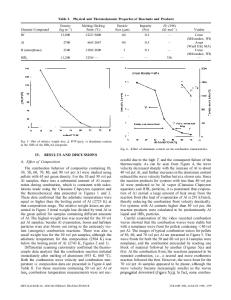Combustion joining of refractory materials: Carbon–carbon composites
- PDF / 676,312 Bytes
- 10 Pages / 585 x 783 pts Page_size
- 49 Downloads / 796 Views
Allen H. Simpson Honeywell Aerospace, South Bend, Indiana 46628
Alexander S. Shteinberg ALOFT, Berkeley, California 94708
Alexander S. Mukasyana) Department of Chemical and Biomolecular Engineering, University of Notre Dame, Notre Dame, Indiana 46556 (Received 18 July 2007; accepted 20 September 2007)
Refractory materials such as carbon possess properties that make joining them difficult. In this work, bonding of a carbon–carbon composite is achieved by employing self-sustained, oxygen-free, high-temperature combustion reactions. The effects of several parameters, such as the composition of the reaction media, and the values of the applied current and pressure, on the mechanical strength of the joint were investigated. It was found that the C–C composite possesses a high activity with the reactive media layer, the level of electrical current used to initiate the reaction and the applied pressure do not need to be excessive to obtain a strong joint. Some aspects of the joining mechanism are discussed in detail.
I. INTRODUCTION
Carbon–carbon (C–C) composites have low density and a high strength-to-weight-ratio, and are able to withstand high temperatures. This combination of properties makes C–C composites well suited for a variety of applications including turbine engine components, the nosecone and leading edges of the wings of space shuttles,1 and carbon brakes.2 As the number of relevant applications for such materials increase, technology for joining the C–C components will need to be developed to produce a wider variety of sizes and geometries. More specifically, an effective bonding method would be of great benefit to existing industries that manufacture C–C components, such as Honeywell Aerospace (South Bend, IN).3 For example, through C– C joining, Honeywell Aerospace could perform a refurbishment of the carbon brakes by bonding a new thin C–C element to a used “core” to produce a brake that meets the performance specifications. The combustion-joining (CJ) method, which will be described further, is an attractive approach for bonding refractory materials. Advances in materials joining using combustion phenomena have been discussed in detail in a recent review.4 a)
Address all correspondence to this author. e-mail: [email protected] DOI: 10.1557/JMR.2008.0008 160 J. Mater. Res., Vol. 23, No. 1, Jan 2008 http://journals.cambridge.org Downloaded: 14 Mar 2015
Selecting an appropriate joining method is dictated not only by the material, but also by the geometry of and intended use for the finished part. Example techniques include mechanical means (e.g., screws, nails, and bolts), adhesives (e.g., glues and epoxies), soldering, and welding. Welding is typically reserved for use with metals, and even refractory compositions (i.e., those with high melting temperature) can be welded if enough control is exercised over the welding conditions. However, joining C–C composites is not a simple task. Mechanical or adhesive means could be used with such materials, but the application would be severely limited. For exampl
Data Loading...











